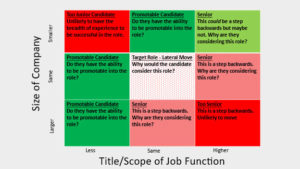All our clients want us to help them find the “ideal” candidate for their organization but understanding what is ideal or what perfect “fit” really means is easier said than done. Over the years, as a way to ensure we isolate what fit means for a particular role, we’ve developed a proprietary selection model that provides a framework for understanding the needs of the client along six different dimensions. We don’t have a standardized set of questions we ask, instead we have a framework that guides us though the areas we need to explore with the client.
One of the dimensions in our selection process is called Environment. Environment is a somewhat misleading term but it means all of the resources (people and financial) and tools (physical and technical) that are provided to the candidate in a particular position to help them achieve the desired results of the position. As you can imagine, different positions have a different mix of resources and tools available for each position. Moreover, companies provide different levels of resources and tools to similarly titled positions at other companies. The importance of the position to one company relative to another company explains some of the discrepancy in the mix of resources and tools. The life cycle of the company or specific product line can also explain varying levels of resources given. The size of the company can also drive the level of resources and tools provided.
Candidates that have lots of resources at their disposal could be at a disadvantage working in a similar company without the same level of support. While this may seem intuitive, we have found that few clients have a systematic way to take into consideration the level of resources and tools available as a factor in the search. In fact, what we often find is a real misalignment in expectations between the results required from a position, the resources they initially believe they should provide to achieve the results, and the set of circumstances that candidates available in the marketplace have at their disposal to do their current job.
By asking lots of questions, we learn the strategic and financial importance of the position. We then quantify the levels of resources and tools available given the size of the company and the lifecycle of the product/company to reduce any misalignment. We then contrast what we have learned against what is available in the market to construct our search strategy.
The result of this analysis helps us identify the set of companies we can target to headhunt candidates from and helps us understand the potential pros and cons when evaluating the fit of the candidate to our client’s specific needs. The diagram below, we portray our client’s position in the center and we evaluate the size of the target companies on the vertical axis and the scope/title of the position on the horizontal.
The resulting diagram highlights the various tradeoffs we need to consider when evaluating candidates for our client’s position. We use this diagram and our Environment analysis when interviewing the candidates and discussing suitability of these candidates with our client. Doing this as part of our selection process gives our client a more structure and objective way of evaluating candidates for the role.
Article written by Carl Denny, CFR Global Executive Search USA
Photo source: Pexels

